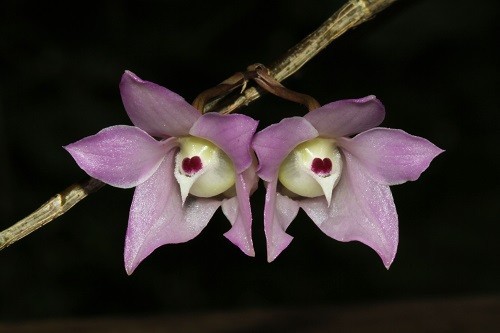Orchids comprise one of the largest groups of flowering plants. Known scientifically as the “Orchidaceae” family, there are around 28,000 currently accepted species in approximately 760 genera. This very diverse family is found on every continent except Antarctica.
Many orchid species are epiphytes or geophytes, meaning that they grow by clinging on to a support (ie. a tree) or rock, rather than putting their roots into the ground. The orchids that have adapted to this lifestyle have modified aerial roots. These roots can be several metres long, and the older parts of them are adapted to absorb water from the air.
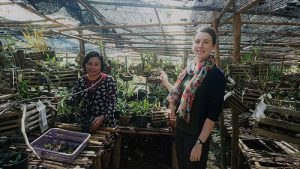
PTK orchid expert Nyai (left), and PTK botanist Bryony (right) working in the orchid nursery together.
When someone says the word “orchid” to you, it is likely that you envision a spray of long-lasting, large, multi-coloured, vibrant blooms. While there are certainly orchids that fit this description, there are also tiny plants with miniscule green flowers; single ephemeral flowers tucked out of sight amidst foliage and plants that give off a stench to attract pollinators.
Many of the orchids with large, brightly coloured flowers are hybrid orchids. These are orchids that have been bred by people to create attractive displays. According to the Royal Horticulture Society (RHS) there are over 110,000 different man-made orchid hybrids in existence, with more than 3,000 new ones being created every year.
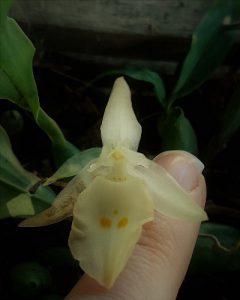
Panisea tricallosa, a Laos native orchid species, can be challenging to photograph – thus the finger in this picture!
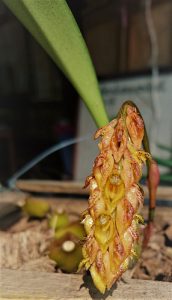
The flowers of many species of Bulbophyllum are very small, but perfectly formed.
Indochina is widely acknowledged as a centre of orchid diversity, and this is due to the huge number of species found in this part of the world. Our knowledge of orchids in the whole region is incomplete, but even so we know about 1,400 different Indochinese species! The number of Laotian species we are aware of is probably just scratching the surface – after all, there are large areas of the country where the plants have never been studied.
One way in which orchids are well known in Laos is as medicine. Many species are used for various complaints, from stomach aches through to assisting in the healing of fractures. The orchid family is widely used in Asia for traditional medicines, and there remains a big demand in most countries in the region. China, with its large population, is by far the biggest consumer of plants for traditional medicinal purposes. Due to high demand and local controls on collection, plants for the Chinese market are often collected in neighbouring countries, including Laos. Because these plants are taken from the wild, rather than cultivated, this has a negative effect on their populations.
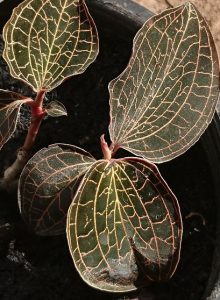
A beautiful Jewel Orchid (Anoectochilus sp.), a genus of orchids now rare in Laos.
Here at Pha Tad Ke we want to continue to expand our orchid collection, and to do so by exploring Laos and discovering what exciting species are out there. We have plans for a ‘Mist House’, one of our big priority projects for 2017. This house will provide a cool, damp, shaded area to display some of our orchids, ferns and carnivorous plants. We are still USD20,000 short of the funding we need for this to go ahead, so the first step is finding a sponsor for this. Please drop us a line if you know of anyone who may be interested in helping us out!
By Bryony Smart, PTK Botanist



